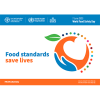World Food Safety Day, organized by the World Health Organization in June each year, is a crucial reminder of the importance of safe food practices and the need to reduce foodborne risks. While awareness campaigns play an essential role in highlighting the significance of food safety, these efforts must be supplemented with concrete actions by businesses, organizations, and government institutions. To create a lasting impact, it is imperative to establish clear Key Performance Indicators (KPIs), allocate appropriate budgets, and set realistic timelines.
The Current Approach: Awareness and Advocacy
Campaigns and conferences serve as platforms for knowledge sharing, raising awareness, and fostering collaborations among stakeholders. They bring together experts, policymakers, and industry leaders to discuss challenges and share best practices. These events can inspire action and provide valuable insights into the latest developments in food safety.
However, the challenge lies in translating discussions into tangible actions. Without a structured approach, the momentum generated during these events can wane, leaving the critical issues of food safety unaddressed. Therefore, while advocacy is a vital first step, it is not sufficient on its own.
The Need for Clear KPIs
To move from dialogue to action, businesses and organizations must establish clear KPIs. These metrics will provide measurable goals to ensure food safety standards are met and maintained. KPIs should cover various aspects, including:
- Compliance Rates: Tracking the adherence to local and international food safety regulations.
- Incident Reduction: Monitoring the number and severity of foodborne illness outbreaks.
- Reduction in the number of recalls: Reduced recalls means improved processes and reduced food waste and savings for businesses.
- Training and Education: Measuring the effectiveness of food safety training programs for employees.
- Consumer Feedback: Collecting and analyzing consumer complaints and feedback related to food safety.
- Supply Chain Audits: Regularly auditing suppliers to ensure they meet food safety standards.
By setting these KPIs, organizations can track progress, identify areas for improvement, and hold themselves accountable.
Budget Allocation
Implementing effective food safety measures requires financial investment. Governments and businesses must allocate sufficient budgets to:
- Infrastructure Improvement: Upgrading facilities to meet food safety standards.
- Technology Integration: Investing in technologies such as traceability systems, automated monitoring, and testing equipment.
- Research and Development: Supporting research into new methods and technologies for improving food safety.
- Training Programs: Developing and delivering comprehensive training programs for employees at all levels.
A well-defined budget ensures that the necessary resources are available to implement and sustain food safety initiatives.
Realistic Timelines
Setting realistic timelines is essential for the successful implementation of food safety measures. Timelines should be based on the complexity of the tasks and the resources available. A phased approach can be effective, starting with high-priority areas and gradually expanding to cover all aspects of food safety.
For example, an organization might set a timeline to achieve the following:
- Short-term (6 months): Conduct initial audits, identify critical gaps, and begin staff training programs.
- Medium-term (1-2 years): Upgrade facilities, implement new technologies, and establish a robust monitoring system.
- Long-term (3-5 years): Achieve full compliance with all food safety regulations, continuously improve processes, and maintain a culture of food safety.
Collaboration and Accountability
Effective food safety requires collaboration among all stakeholders, including government agencies, businesses, non-governmental organizations, and consumers. Each party must understand its role and responsibilities. Governments should enforce regulations and provide guidance, businesses must implement and maintain food safety practices, and consumers should be informed and vigilant.
Accountability mechanisms, such as regular audits, public reporting of food safety performance, and penalties for non-compliance, are crucial for ensuring that all stakeholders adhere to their commitments.
Conclusion
World Food Safety Day is a valuable starting point, but it is not enough. To make a meaningful impact, businesses, organizations, and government institutions must set clear KPIs, allocate appropriate budgets, and establish realistic timelines. By doing so, they can ensure that food safety initiatives move beyond awareness and advocacy to create real, lasting change. Only through concerted and sustained efforts can we achieve the goal of safe food for all.





